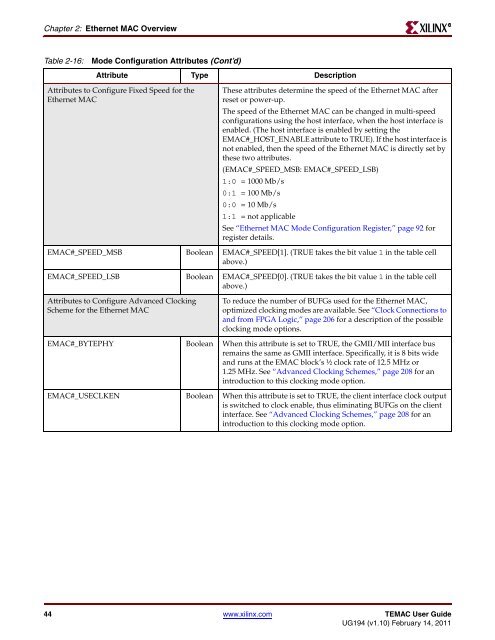Xilinx UG194 Virtex-5 FPGA Embedded Tri-Mode Ethernet MAC ...
Xilinx UG194 Virtex-5 FPGA Embedded Tri-Mode Ethernet MAC ...
Xilinx UG194 Virtex-5 FPGA Embedded Tri-Mode Ethernet MAC ...
You also want an ePaper? Increase the reach of your titles
YUMPU automatically turns print PDFs into web optimized ePapers that Google loves.
Chapter 2: <strong>Ethernet</strong> <strong>MAC</strong> Overview<br />
Table 2-16: <strong>Mode</strong> Configuration Attributes (Cont’d)<br />
Attribute Type Description<br />
Attributes to Configure Fixed Speed for the<br />
<strong>Ethernet</strong> <strong>MAC</strong><br />
These attributes determine the speed of the <strong>Ethernet</strong> <strong>MAC</strong> after<br />
reset or power-up.<br />
The speed of the <strong>Ethernet</strong> <strong>MAC</strong> can be changed in multi-speed<br />
configurations using the host interface, when the host interface is<br />
enabled. (The host interface is enabled by setting the<br />
E<strong>MAC</strong>#_HOST_ENABLE attribute to TRUE). If the host interface is<br />
not enabled, then the speed of the <strong>Ethernet</strong> <strong>MAC</strong> is directly set by<br />
these two attributes.<br />
(E<strong>MAC</strong>#_SPEED_MSB: E<strong>MAC</strong>#_SPEED_LSB)<br />
1:0 = 1000 Mb/s<br />
0:1 = 100 Mb/s<br />
0:0 = 10 Mb/s<br />
1:1 = not applicable<br />
See “<strong>Ethernet</strong> <strong>MAC</strong> <strong>Mode</strong> Configuration Register,” page 92 for<br />
register details.<br />
E<strong>MAC</strong>#_SPEED_MSB Boolean E<strong>MAC</strong>#_SPEED[1]. (TRUE takes the bit value 1 in the table cell<br />
above.)<br />
E<strong>MAC</strong>#_SPEED_LSB Boolean E<strong>MAC</strong>#_SPEED[0]. (TRUE takes the bit value 1 in the table cell<br />
above.)<br />
Attributes to Configure Advanced Clocking<br />
Scheme for the <strong>Ethernet</strong> <strong>MAC</strong><br />
To reduce the number of BUFGs used for the <strong>Ethernet</strong> <strong>MAC</strong>,<br />
optimized clocking modes are available. See “Clock Connections to<br />
and from <strong>FPGA</strong> Logic,” page 206 for a description of the possible<br />
clocking mode options.<br />
E<strong>MAC</strong>#_BYTEPHY Boolean When this attribute is set to TRUE, the GMII/MII interface bus<br />
remains the same as GMII interface. Specifically, it is 8 bits wide<br />
and runs at the E<strong>MAC</strong> block’s ½ clock rate of 12.5 MHz or<br />
1.25 MHz. See “Advanced Clocking Schemes,” page 208 for an<br />
introduction to this clocking mode option.<br />
E<strong>MAC</strong>#_USECLKEN Boolean When this attribute is set to TRUE, the client interface clock output<br />
is switched to clock enable, thus eliminating BUFGs on the client<br />
interface. See “Advanced Clocking Schemes,” page 208 for an<br />
introduction to this clocking mode option.<br />
44 www.xilinx.com TE<strong>MAC</strong> User Guide<br />
<strong>UG194</strong> (v1.10) February 14, 2011<br />
R

















